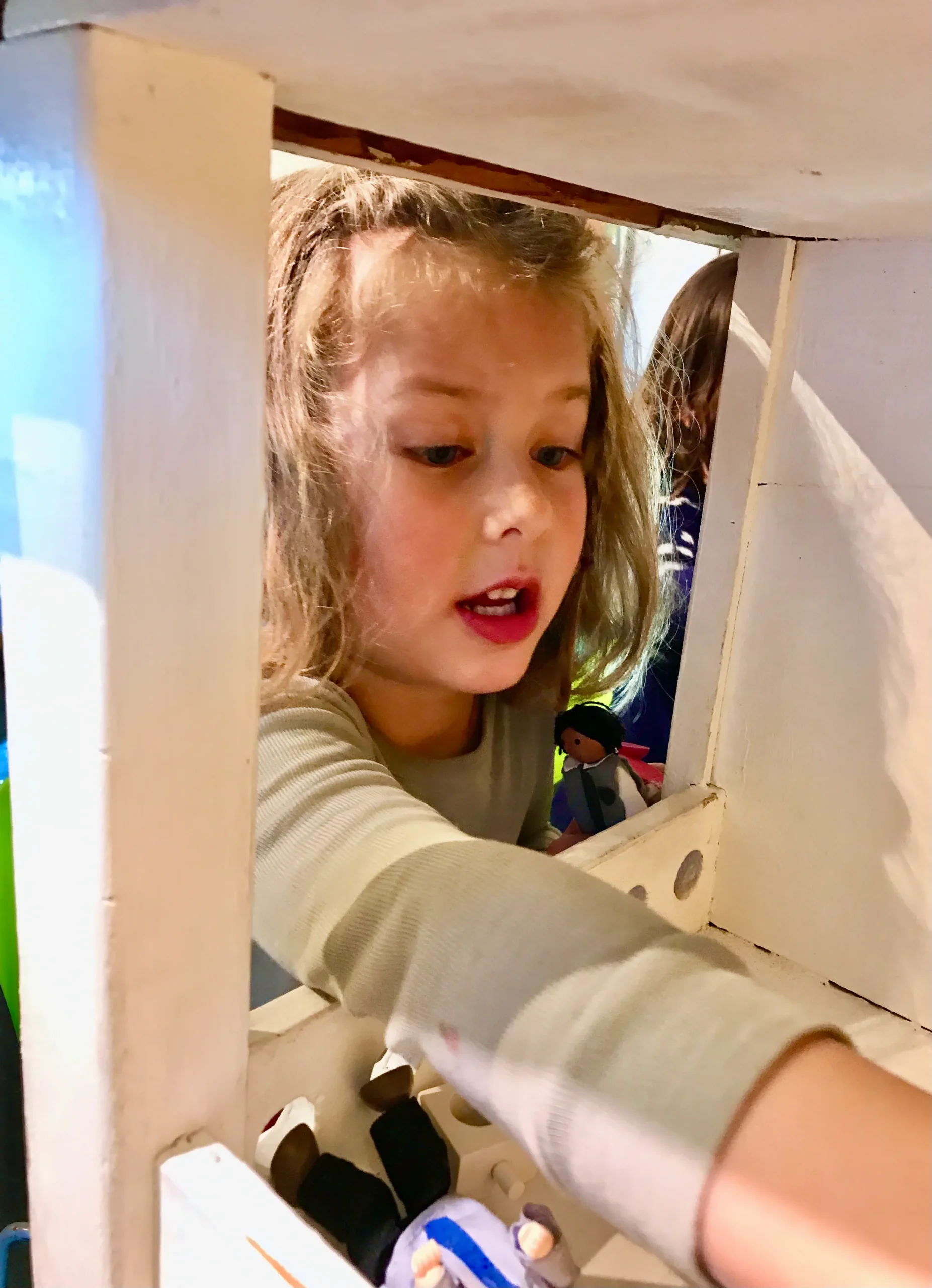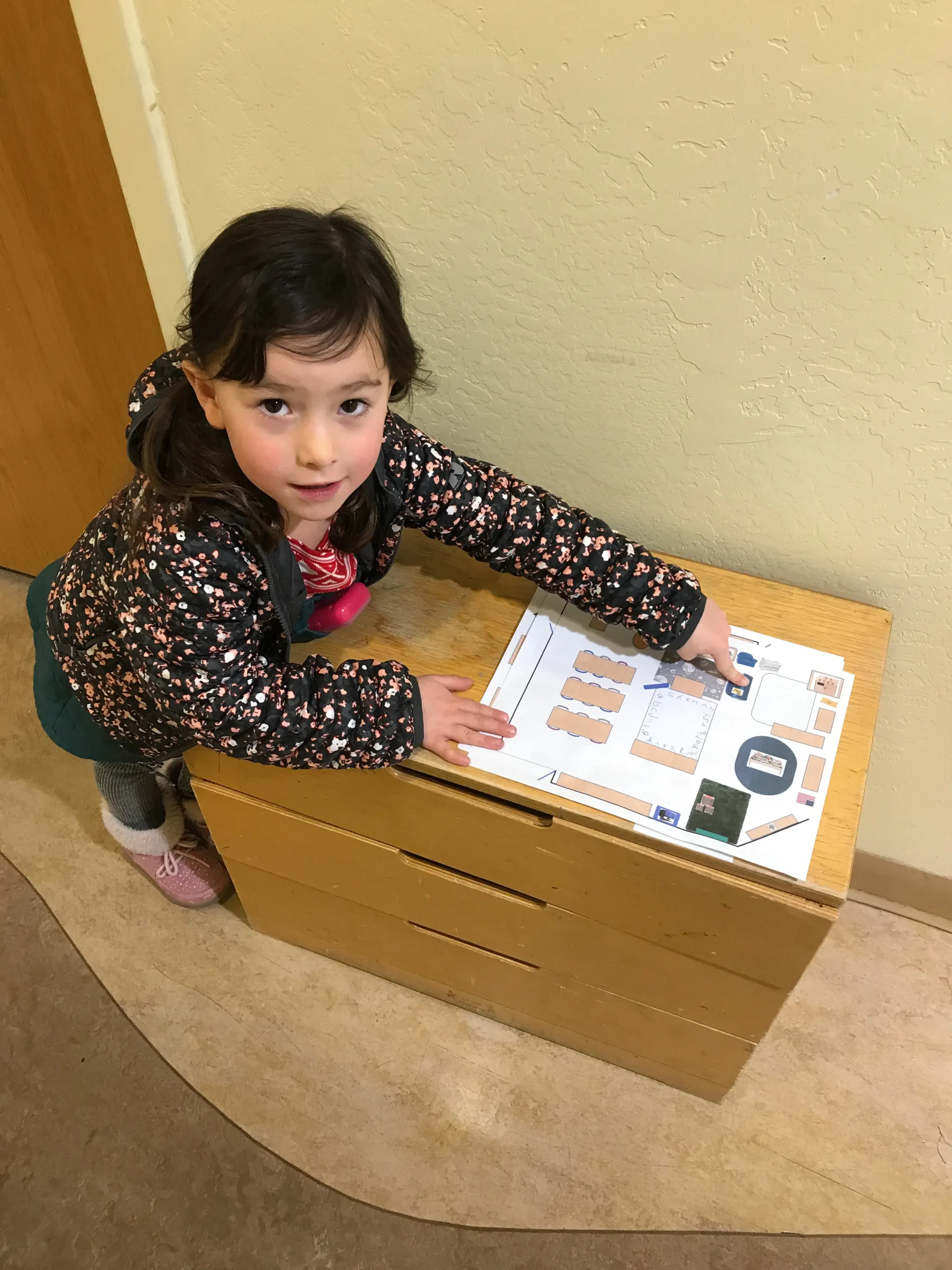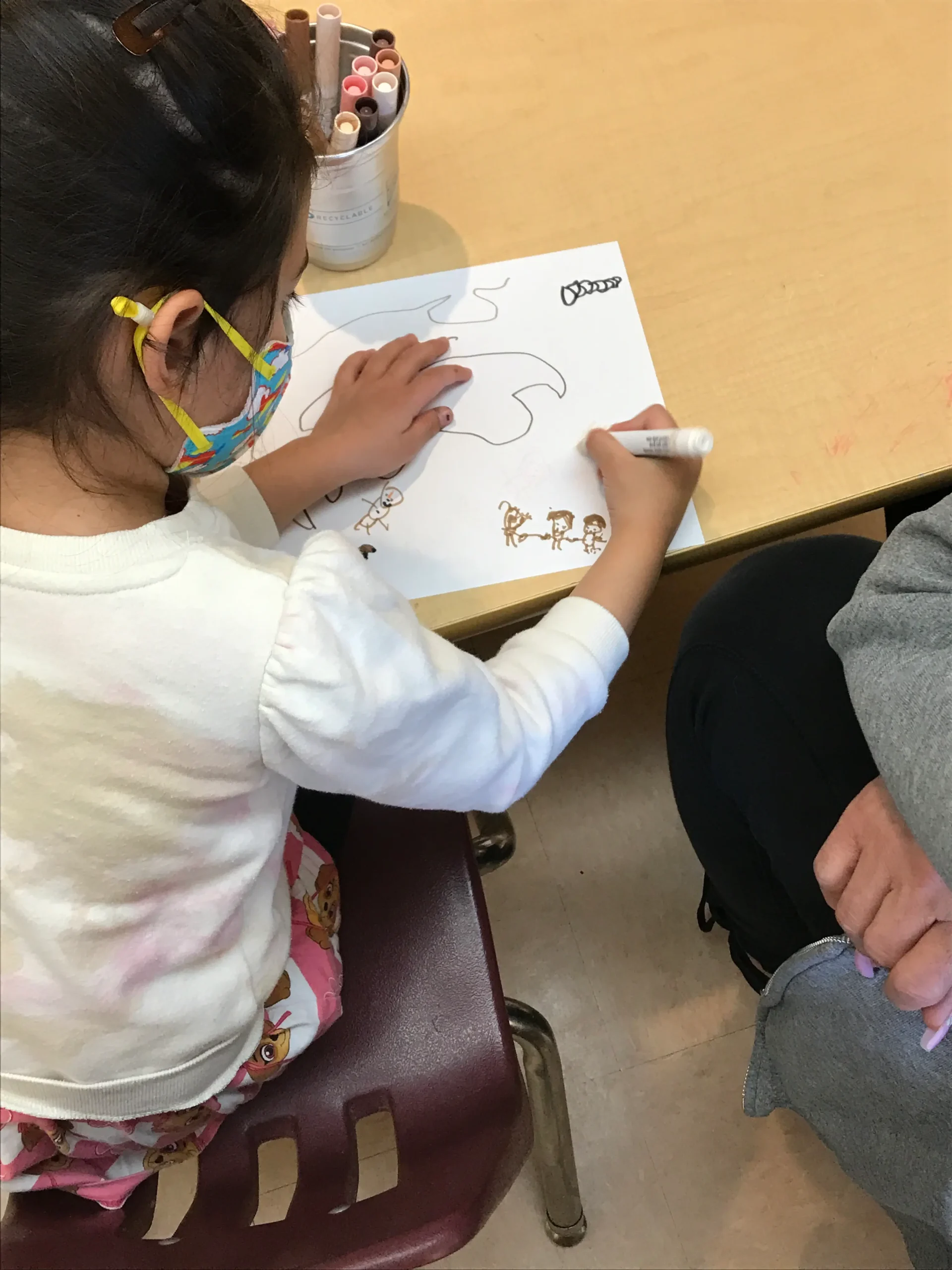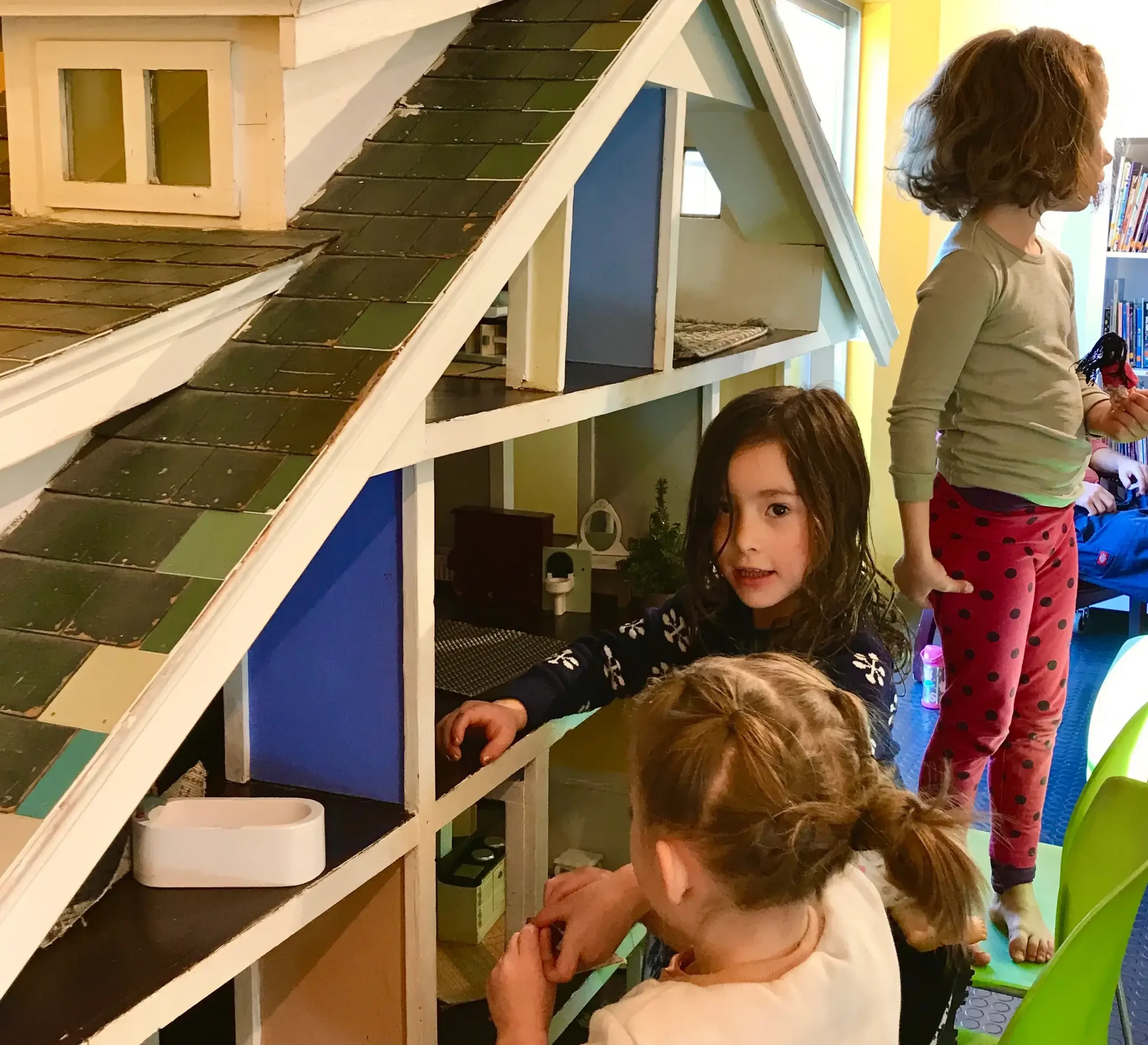Courtesy photo: Three four-year-olds play with the giant dollhouse at the Santa Fe Children’s Museum
Back at the Children’s Museum…
By Annabelle Black Delfin
*Castle Park is under a slow de-construction. Due to this, this edition of Conversations in Castle Park actually took place at the Santa Fe Children’s Museum.
Recently, I found myself sitting with several other parents and grandparents watching our little ones play with the giant dollhouse at the Santa Fe Children’s Museum. As usual, our conversation turned to observations about the children, especially since this group of four-year-olds have been friends for years and that meant we adults had the opportunity to observe their growth and development over time. A grandmother remarked that her granddaughter was beginning to comprehend and point out symbols. Another was amazed by how adept her granddaughter is with navigating the smart phone to find the photo file. We all laughed when we acknowledged that comprehension of technology already seemed to come easily for these young children.
This observation often comes up and is one of the research questions being examined in a research project which began at the First Presbyterian Child Development Center in Santa Fe that observes young children as they participate in activities centered on symbolic representation, map-use, and map-making. The research project, called the Treasure Map Experience, emanates out of the New Mexico Center of Excellence for Early Childhood Education in Silver City, was launched in September 2022 with two sites, Santa Fe and the WNMU Child Development Center. The focus of the project is on children’s cognitive development as they make sense of symbols and navigate technology.

Courtesy photo: A four-year-old arranges the furnishings of the dollhouse at the Santa Fe Children’s Museum.
As an early childhood researcher, I spend a lot of time in early childhood settings where I have observed hundreds of children over the years. Along with my research partner, Dr. Wenjie Wang of Western New Mexico University, we have studied language development in dramatic play, children’s symbolic development in learning Chinese characters, and children’s use of mental representation, among other topics. Our latest research project is focused on cognitive development, particularly in looking at how children discern meaning from symbols. We thought that map use and map making would be a good way to examine this with preliterate children. The child participants have fun using maps to seek ‘treasure’, making maps of their classroom and neighborhoods and learning about the many types of maps and ways they can be used. Back at the Children’s Museum, one of my former students, now employed as a Home Visitor, was working with a family with two young children. She introduced me to the parents. One parent showed her son a visual timer app on her phone and said, “Five more minutes, then we have to go home.” Her four year old looked at the screen, nodded and re-entered play in the pretend grocery store. He told his little brother, “Five more minutes”. The adults laughed because the children displayed understanding of the abstract concept of time and the visual display on the phone screen. This brief interaction demonstrates much about this current research project.
As Dr. Wenjie Wang notes, “One of the things that we are exploring is if general exposure to technology, where preliterate children are using symbols to access and interact with technology, may be decreasing the age at which children begin to make meaning from symbols and use of symbols to convey meaning.” In other words, we suspect that the pervasiveness of technology in society may be making children develop abstract thought and symbolic representational abilities at younger ages than children in the past who were not exposed to technology. The implication for this is that children may be learning the concepts of symbolic representation earlier, in turn, constructing a neural foundation that facilitates earlier literacy acquisition.
Understanding how children interpret and use symbols is important as symbolic representation is the basis of language and literacy. Literacy and how to teach children to read have become paramount in Governor Lujan Grisham’s legislative and policy agenda. Back at the Children’s Museum, one of the parents mentioned that they have been following this initiative and asked what is meant by the term ‘structured literacy’ in relation to early childhood.
An ongoing debate in early childhood education concerns when children are old enough to learn to read. Some people say young children are in a concrete stage of development and are not ready for abstraction until they are older. And some people think that children will incorporate abstraction, such as understanding symbols, if they are exposed to it.

Courtesy photo: A four year old points to the treasure location on a map of her classroom.
In the reading debate, one side is focusing on environmental exposure- this is the Whole Language perspective- giving children many varied experiences in language-rich environments and they will absorb language, and thus reading. The other side, coming to be called the ‘Science of Reading’ and ‘structured literacy’ sees direct instruction of phonics and letter recognition as necessary for learning to read. We suspect the answer involves both perspectives- exposure and direct instruction. In early childhood circles, it has been seen as developmentally inappropriate to introduce letters and numbers (i.e. symbols) before children were developmentally ready for them. But we are seeing more and more young children who know how to navigate a smart device by way of symbols- logos, icons, ‘tabs’, etc. We want to see how this early use of symbols may be changing with young children who are exposed to technology.
Our preliminary findings suggest that the best way parents and families can support their young children in learning to read is two-part: 1. exposure in a language-rich and symbol-infused environment. From the child’s point of view, this means hearing oral language and interacting with others (in conversations, telling/retelling stories, singing, music and verbal descriptions…) It also means having access to a great deal of print, books, pictures, maps, and other symbolic depictions of meaning. The second part, 2. direct instruction in fun activities that make the connection between the sounds of letters and how they combine in words. This is as simple as playing rhyming games, segmenting the sounds in the words, movement associated with syllabic sounds in common words, and matching card games of words that start or end with the same sound. Young children who learn to hear, identify and produce the distinct sounds of the letters have been shown to do better when it is time to take up reading and writing.

Courtesy photo: A child draws a map of her neighborhood.
Back at the Children’s Museum, the timer went off on the mom’s phone app. She showed the screen to her sons and they began to prepare to leave. Another parent laughed and said, ‘That timer app worked like magic!’ Whether we call it literacy, language, or tech skills, everyone could agree that children nowadays are readily understanding more and more meaning from symbols on screens. This early understanding of symbolic representation becomes the basis for literacy, and later, academic content. Parents can support this through conversation and play, verbal interactions and intentionally exposing their kids to lots of books, stories and different types of print and symbols.
The Treasure Map Experience research project is expected to run through 2024. It is a research project of the New Mexico Center of Excellence in Early Childhood, with funding from the New Mexico State University Glass Family Research Institute, in collaboration with the First Presbyterian Child Development Center of Santa Fe.
Annabelle Black Delfin has spent her life in New Mexico. Since starting her first babysitting enterprise as a teen, she has been interested in how young children grow and develop. She has run after-school programs, summer camps, youth-service nonprofits, and child care, among other programs for kids in Santa Fe. Annabelle is a mom of two and has a three-year-old granddaughter. Annabelle is currently a researcher, writer, and instructor at the New Mexico Center of Excellence in Early Childhood Education of WNMU.




